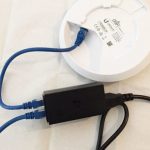For my Discrete Mathematics II course at UCF (COT4210), I had to do some implementation with Finite State Machines. My favorite of our tasks (though the most difficult) was to convert a Regular Expression (RE) to an equivalent Deterministic Finite Automata (DFA). And since our professor let us use any language, I tried to branch out from Java & C (which are annoyingly overused in Academia). I decided to teach myself Python. And it turns out, it was a good choice too--considering it's wonderful built-in functionality for Lists, and the heart of this program is a huge 2D array defining the automata's transition function. Also, I miss scripting languages--especially when I'm writing a program as a learning experiment as opposed to trying to make it as efficient as possible.
So, without further Ado: here's my code. It reads a RE in postfix notation from input.txt. Two cautions about postfix REs:
- You must explicitly state concatenation
- The Kleen Star is already a postfix operator in REs, so it doesn't really work to use a mathematical infix2postfix library, as it treats the kleen star like an infix multiplicative operator. I treat it as an operand and throw it directly into the output rather than placing it on the stack since it's already in postfix.
#!/usr/bin/python2
################################################################################
# Author: Michael Altfield
# Section: COT 4210-0001 (15902) Discrete Structures II T/R 10:30-11:45
# Created: 2011-03-24
# Updated: 2011-04-07
# Version: 1.2
# Assign#: Project #1, Problem #3
# Purpose: Given a regular expression R, construct a DFA that accepts the
# language of R.
################################################################################
################################################################################
# IMPORTS #
################################################################################
# n/a
################################################################################
# SETTINGS #
################################################################################
DEBUG = False # True enables DEBUG output. False disables.
#DEBUG = True
# input file describing our DFA
inputFileName = 'three.txt'
# all legal operators: concatenation, union, and kleen star
# (everything else in the regular expression will be considered an input symbol)
operators = [ '.', '+', '*' ]
# set to False if you see ^[[1m and ^[[0;0m showing up in the output
enableBoldOutput = True
bold = "33[1m"
reset = "33[0;0m"
################################################################################
# FUNCTIONS #
################################################################################
# prints debug info when DEBUG flag set to True
def debug( msg ):
if( DEBUG ):
print "DEBUG: " + msg
# returns a string representation of the Transition Table in a technical
# human-moar-leik-engineer readable format
def transitionTable2Str():
return str(transitionTable)
# returns a string representation of the Transition Table in a technical
# human-moar-leik-engineer readable format
def curSubNfaList2Str():
return str(curSubNfaList)
# returns a string representation of the NFA in a human readable format
def automata2Str():
####################
# DEFINE VARIABLES #
####################
states = ''
sigma = ''
delta = ''
###############
# NFA or DFA? #
###############
# do we have epsilon transitions in this Transition Table?
print epsilon
if len(transitionTable[0]) > epsilon:
# we have epsilon transitions in this Transition Table (or at least we
# have epsilon transitions to [None] in this Transition Table)
printingNfa = True
else:
printingNfa = False
###################################
# BUILD HUMAN-READABLE STATES SET #
###################################
states += '{'
# LOOP THOUGH ALL ROWS OF THE TRANSITION TABLE
counter = 0
while counter < len(transitionTable):
# is this our first state?
if not states == '{':
# this is not our first state, so prepend a comma & space
states += ', '
# the name of each state is merely its index in the Transition Table, so
# just append the counter to our set of states
states += str(counter)
counter += 1
states += '}'
#####################################
# BUILD HUMAN-READABLE ALPHABET SET #
#####################################
sigma += '{'
# LOOP THOUGH ALL THE ELEMENTS (SYMBOLS) IN THE ALPHABET
for symbol in alphabet:
# is this our first symbol?
if not sigma == '{':
# this is not our first symbol, so prepend a comma & space
sigma += ', '
sigma += symbol
sigma += '}'
#########################################
# BUILD HUMAN-READABLE TRANSITION TABLE #
#########################################
delta = ' '
# PRINT TOP ROW OF TABLE (SYMBOLS IN ALPHABET)
if enableBoldOutput:
delta += bold
# loop through all symbols in the alphabet
for symbol in alphabet:
delta += '{0:^10}'.format( str(symbol) ) + ' '
# are we printing an NFA?
if printingNfa == True:
# we are priting an NFA; create a column for epsilon transitions
delta += '{0:^10}'.format( 'epsilon' ) + ' '
if enableBoldOutput:
delta += reset
delta += "n"
# ITERATE THROUGH EACH FOLLOWING ROW (STATES)
counter = 0
for row in transitionTable:
# print the first element of the row (the transition-from state)
if enableBoldOutput:
delta += bold
delta += '{0: | left "out" State |
# ----------------- ------------------
# ------------------ -------------------
# | right "in" State | ----> | right "out" State |
# ------------------ -------------------
#
# into this:
# ----- ------ ------ ------
# | LiS | ----> | LoS | ----> | RiS | ----> | RoS |
# ------ ------ ------ ------
#
def concatenateCurSubNfa():
###############################
# ADD ARC TO TRANSITION TABLE #
###############################
# we concatenate 2 sub-NFAs by creating an arc from the "left" sub-NFA's
# "out" State to the "right" sub-NFA's "in" State
# -2 index = "left" sub-NFA
# 1 subindex = "out" State
leftExitState = curSubNfaList[-2][1]
# -1 index = "right" sub-NFA
# 0 subindex = "in" State
rightEnterState = curSubNfaList[-1][0]
debug( "Adding an epsilon transition from state " +str(leftExitState)+
" to state " +str(rightEnterState) )
transitionTable[ leftExitState ][ epsilon ] = [rightEnterState]
debug( "tTransition Table = " )
debug( "tt" + transitionTable2Str() )
#####################################################
# MERGE SUB-NFAs TO SINGLE SUB-NFA IN curSubNfaList #
#####################################################
debug( "Merging the 2 sub-NFAs in curSubNfaList" )
# -1 index = "right" sub-NFA
# 1 subindex = "out" State
outState = curSubNfaList[-1][1]
# set the "left" sub-NFA's "out" State to be the "right" sub-NFA's "out"
# State
# -2 index = "left" sub-NFA
# 1 subindex = "out" State
curSubNfaList[-2][1] = outState
# ..and delete the now-orphaned "right" sub-NFA
curSubNfaList.pop()
debug( "tcurSubNfaList = " )
debug( "tt" + curSubNfaList2Str() )
# turn this:
# ---------------- -----------------
# | top "in" State | ----> | top "out" State |
# ---------------- -----------------
# ------------------- --------------------
# | bottom "in" State | ----> | bottom "out" State |
# ------------------- --------------------
# ------------------
# | new "left" State |
# ------------------
# -------------------
# | new "right" State |
# -------------------
#
# into this:
# e ----- ------
# --->| TiS | ----> | ToS |
# ----- / ------ ------ e -----
# | NlS | ===> | NrS |
# ----- e ----- ------ / e -----
# --->| BiS | ----> | BoS |
# ------ ------
#
def unionCurSubNfa():
#################################
# ADD 2 STATES TO OUR FINAL NFA #
#################################
debug( "tTransition Table = " )
debug( "tt" + transitionTable2Str() )
# get the current number of States from the number of rows of the transition
# table. Subtract 1 to start from 0.
numStates = len( transitionTable ) - 1
newLeftState = numStates+1
newRightState = numStates+2
debug( 'Adding states ' +str(numStates+1)+' & ' +str(numStates+2)+
' to the NFA' )
##############################################
# INSERT NEW LEFT STATE INTO TRANSTION TABLE #
##############################################
# build a row to add to the Transition Table for our "left" State that has
# an epsilon transition to each current sub-NFA's "in" State
row = [ [None] for i in range( len(alphabet) ) ]
# -2 index = "top" sub-NFA
# 0 subindex = "in" State
topInState = curSubNfaList[-2][0]
# -1 index = "bottom" sub-NFA
# 0 subindex = "in" State
bottomInState = curSubNfaList[-1][0]
debug( "Adding an epsilon transition from state " +str(newLeftState)+ " to "
"states " +str(topInState)+ " & " +str(bottomInState) )
# add a epsilon transitions to both current sub-NFAs
row.append( [topInState, bottomInState] )
transitionTable.append( row )
###############################################
# INSERT NEW RIGHT STATE INTO TRANSTION TABLE #
###############################################
# build a row to add to the Transition Table for our "right" State with no
# "out" transitions
row = [ [None] for i in range( len(alphabet) ) ]
# add a final epsilon transition
row.append( [None] )
transitionTable.append( row )
#######################################################
# INSERT ARC TO NEW RIGHT STATE INTO TRANSITION TABLE #
#######################################################
# -2 index = "top" sub-NFA
# 1 subindex = "out" State
topOutState = curSubNfaList[-2][1]
# -1 index = "top" sub-NFA
# 1 subindex = "out" State
bottomOutState = curSubNfaList[-1][1]
debug( "Adding epsilon transitions from states " +str(topOutState)+ " & "
+str(bottomOutState)+ " to state " +str(newRightState) )
# add an epsilon transition from the top sub-NFA's "out" State to the new
# "right" State
transitionTable[ topOutState ][ epsilon ] = [newRightState]
# add an epsilon transition from the top sub-NFA's "out" State to the new
# "right" State
transitionTable[ bottomOutState ][ epsilon ] = [newRightState]
debug( "tTransition Table = " )
debug( "tt" + transitionTable2Str() )
#####################################################
# MERGE SUB-NFAs TO SINGLE SUB-NFA IN curSubNfaList #
#####################################################
# "in" State of merged sub-NFA
curSubNfaList[-2][0] = newLeftState
# "out" State of merged sub-NFA
curSubNfaList[-2][1] = newRightState
# ..and delete the now-orphaned "bottom" sub-NFA
curSubNfaList.pop()
debug( "tcurSubNfaList = " )
debug( "tt" + curSubNfaList2Str() )
# turn this:
# ---------------------- -----------------------
# | current "left" State | ----> | current "right" State |
# ---------------------- -----------------------
# ------------------
# | new "left" State |
# ------------------
# -------------------
# | new "right" State |
# -------------------
#
# into this:
# ----- e ----- ----> ----- e -----
# | NlS | ----> | ClS | e | CrS | ----> | NrS |
# ----- e ----- 0):
# get the next token from the beginning of the regularExpression string
token = regularExpressionList.pop(0)
debug( "WORKING WITH TOKEN '" +str(token)+ "' FROM THE REGULAR EXPRESSION" )
if token in operators:
# the token is an operation
subNfaOperation( token )
else:
# the token is a symbol
createNfaFromSymbol( token )
#####################
# PRINT EPSILON-NFA #
#####################
print "The following epsilon-NFA is equivalent to the supplied Regular "
"Expression (" +str(regularExpression)+ "):"
print automata2Str()
#####################################
# CONVERT THE EPSIOLON-NFA TO A DFA #
#####################################
debug( "---BEGIN CONVERTING EPSILON-NFA TO A DFA---" )
# DEFINE VARIABLES
newTransitionTable = []
newStates = []
addedStates = []
# following the Subset Construction Algorithm, the first State of our DFA is the
# Epsilon Closure of the first state of our epsilon-NFA
startState = epsilonClosure( curSubNfaList[0][0] )
newStates.append( startState )
while len(newStates) > 0:
newTransitionTable.append( [] )
state = newStates.pop(0)
addedStates.append( state )
debug( "Adding State " +str(state)+ " to DFA with new State name = "
+ str(len(newTransitionTable)-1) )
# loop through all symbols in the alphabet + epsilon transitions
counter = 0
while counter = len(alphabet):
symbol = ''
else:
symbol = alphabet[counter]
# has this state already been added to the new DFA?
if not transitionTo == [] and not transitionTo == [None] and not transitionTo in newStates and not transitionTo in addedStates:
# this state has not already been added to the new DFA; add it to the
# newStates list so it'll be added in a future iteration
newStates.append( transitionTo )
if transitionTo in addedStates:
newStateIndex = addedStates.index( transitionTo )
elif transitionTo in newStates:
newStateIndex = newStates.index(transitionTo) + len(newTransitionTable)
debug( "Adding transition from State " +str(state)+ " = "
+str(len(newTransitionTable)-1)+ " to State " +str(transitionTo)
+" = " +str(newStateIndex)+ " on input symbol '" +str(symbol)+ "'"
)
newTransitionTable[ len(newTransitionTable)-1 ].append( extendedDelta( state, counter ) )
counter += 1
debug( "tTransition Table = " )
debug( "tt" + transitionTable2Str() )
# overwrite the transitionTable with the new one now that we no longer need it
# (automata2Str() uses transitionTable)
transitionTable = newTransitionTable
#############
# PRINT DFA #
#############
print "The following DFA is equivalent to the above epsilon-NFA and the "
"original Regular Expression (" +str(regularExpression)+ "):"
print automata2Str()
################
# EXIT CLEANLY #
################
exit(0)
Of course, this work is mine and not yours. If you manage to get some better understanding of Discrete or Python from it, great--but you don't have my permission to submit it as your own work.
Related Posts
Hi, I’m Michael Altfield. I write articles about opsec, privacy, and devops ➡









While I would like to comment on this post, it is nearly impossible without proper code formatting try using some pre tags and a javascript syntax highlighter such as http://alexgorbatchev.com/SyntaxHighlighter/
@Sam, I had something similar to this a while back, but a WordPress update broke it, and I haven't yet had a chance to fix it. Google Code actually has something similar to this, which I have yet to implement.
Hi,where is the result of automata2Str?